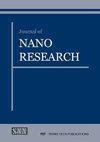绿色法和静电纺丝法合成ZnO纳米材料的比较研究
IF 1
4区 材料科学
Q4 MATERIALS SCIENCE, MULTIDISCIPLINARY
引用次数: 2
摘要
本文对ZnO纳米锥和纳米纤维进行了比较研究。以印楝叶提取物为培养基,采用绿色路线合成ZnO纳米锥,采用静电纺丝法合成ZnO纳米纤维。采用粉末x射线衍射仪(XRD)和Rietveld细化分析对制备的纳米材料的微观结构参数进行了研究。XRD谱图证实,锥形纳米颗粒和纤维状纳米颗粒形成了具有六方纤锌矿结构的单相ZnO,平均晶粒尺寸分别为21 nm和54 nm。场发射扫描电镜显示,纳米纤维的平均半径为25 ~ 30 nm,纳米锥的平均高度和平均基半径分别为181 nm和91 nm。基于密度函式理论,使用thermal - pw代码计算弹性柔度S11 (6.0678×10-12 m2N-1)、S12 (-2.2602×10-12 m2N-1)、S13 (-1.3579×10-12 m2N-1)、S33 (5.5196×10-12 m2N-1)和S44 (22.6833×10-12 m2N-1)估算弹性性能。计算得到的两种纳米结构的弹性常数与预期的相似。然而,由于形态异常,两种纳米结构的弹性极限不同。此外,纳米纤维状ZnO的光学带隙比纳米锥形ZnO小。本文章由计算机程序翻译,如有差异,请以英文原文为准。
Comparative Study of ZnO Nanomaterials Synthesized by Green and Electrospinning Methods
This article presents a comparative study between the ZnO nanocone and nanofibers. ZnO nanocones were synthesized through the green route, using Azadirachta indica leaf extract media, and ZnO nanofibers were synthesized by the electrospinning process. The microstructural parameters of the prepared nanomaterials were investigated using powder X-ray diffractometer (XRD) and Rietveld refinement analysis. The XRD patterns confirmed the formation of single-phase ZnO with hexagonal wurtzite structure having an average crystallite size of 21 nm and 54 nm for the conical and fibrous nanoparticles, respectively. The field emission scanning electron microscopy revealed that the mean radius of nanofibers was 25-30 nm while the mean height and mean base radius of nanocones were 181 nm and 91 nm respectively. Elastic properties were estimated using elastic compliances S11 (6.0678×10-12 m2N-1), S12 (-2.2602×10-12 m2N-1), S13 (-1.3579×10-12 m2N-1), S33 (5.5196×10-12 m2N-1) and S44 (22.6833×10-12 m2N-1) which were calculated using the THERMO-PW code, based on the density functional theory. The calculated elastic constants of the two nanostructures yielded similar values as expected. However, the elastic limit of the two nanostructures differs due to their morphological anomaly. Moreover, the optical bandgap of nanofibrous ZnO was lower than that of nanoconical ZnO.
求助全文
通过发布文献求助,成功后即可免费获取论文全文。
去求助
来源期刊

Journal of Nano Research
工程技术-材料科学:综合
CiteScore
2.40
自引率
5.90%
发文量
55
审稿时长
4 months
期刊介绍:
"Journal of Nano Research" (JNanoR) is a multidisciplinary journal, which publishes high quality scientific and engineering papers on all aspects of research in the area of nanoscience and nanotechnologies and wide practical application of achieved results.
"Journal of Nano Research" is one of the largest periodicals in the field of nanoscience and nanotechnologies. All papers are peer-reviewed and edited.
Authors retain the right to publish an extended and significantly updated version in another periodical.
 求助内容:
求助内容: 应助结果提醒方式:
应助结果提醒方式:


